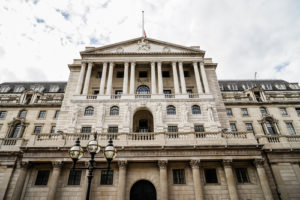
That was quite a week. Before I get my teeth into the economics, we ought to start with Russia. Readers may remember that I have been something of a student of Russian politics since I was a student, logically enough. Russian military action is frequently a sign of unrest in the Kremlin; it tends to be a demonstration that someone has control over the armed forces, or at least large parts of them. We still do not fully understand why Putin chose to invade Ukraine: it may have been to push back against NATO, or it may have been an internal show of power. Wagner’s march to and from Moscow will probably turn out to have been about a combination of money and power: the two are largely interchangeable. Precisely what is going on is anyone’s guess, but it is odds on that it is a clear flag that conflict in the Kremlin has reached breaking point. The waters are troubled and we know neither who is causing the ripples, nor where they will land.
So let me come to the Bank of England and the Federal Reserve. Readers will know that I am not a great fan of the incumbents; the words ‘asylum’ and ‘lunatics’ spring readily to mind. We should recap some of the details of the inflationary upswing in 2021 and 2022. US inflation was in excess of 7% before Russia invaded Ukraine, and over 8% before the Fed finished its last round of quantitative easing. I have repeated these statistics many times, but it is essential to understand that the Central Bankers who control so much of the world’s financial policy have demonstrated a misunderstanding of inflation of historic magnitude. These are the very same office holders who we are now asked to trust to control the very inflation that they caused.
The denial of responsibility, by Andrew Bailey’s Bank of England in particular, is continually astonishing. Nonetheless, it is he who is still in charge. Together with his Monetary Policy Committee, last week they deemed it to be necessary to raise what is so pompously referred to as ‘bank rate’, by a half point to 5%. It is hard to argue against the view that they have now decided that the way to ‘cure’ the inflation that they, and the Fed, caused is a deflationary recession. And, in my view, unless something changes, that is precisely what they are going to cause.
I include the Federal Reserve in this as well. They may have paused, or skipped, an increase in US rates a fortnight ago, but Jay Powell, the leader of this sorry band, last week made it clear that they were merely wiping the sweat and blood from their brow, before they return to the fight in late July. If you will excuse me, here I need to become a little more technical. The United States has what is known as an inverted yield curve. This means that the yield provided by a 10-year treasury is less than that of a 2 year maturity. This differential is currently more than 1%. This is quite rare. Give or take an odd day here and there, a full 1% inversion is almost always followed by two things: first, yet another rate increase, and second, a rapid reversal as it becomes clear that the economy is much worse than thought. History, as we know, does not repeat; but it does give pretty good clues. Equally, past performance may be no guide to the future. Unfortunately, until we crack the space-time continuum, it is the only guide that we do have.
The past 37 or so years have taught me that the financial markets are pretty good at working all this out. Policy will be tightened too far and will be reversed. The wild card this time round is that having so misunderstood the inflationary upswing, so the Central Banks will be too tardy in recognising the economic harm that they are causing. As I have said I think many times before, in my view we are in a new era of financial and economic cyclicality. Or, as an earlier Labour prime minister described, ‘boom and bust’.
It would be remiss to end this week’s diatribe without a more positive conclusion. Portfolio-wise, more than ever it is essential to concentrate on the longer term. There will be times in the next ten years when a 4.5% gilt yield, for example, looks a bargain, and times when it may appear very expensive. But if we take two views: one, that cycles will be short and increasingly unpredictable, and two, that inflation averages, say, 3% over the next decade, then the perspective changes very much for the better. On the equity side of the equation, the eternal arguments for favouring a combination of proved quality and value have never been stronger. There are times when it may appear that investors are rewarded for being clever. This is not one of them. It is a time, above all else, to avoid being stupid.
Finally, congratulations to those who got either part of our last double-header. The lines were from Get Lucky and Rikki Don’t Lose That Number. Today, an easy one from the early ‘80s: “Is it down to the lake, I fear?”, and a Steely Danner: “I know this super-highway, this bright familiar sun.”
Jim Wood-Smith – Market Commentator and Head of Climate Transition

FPC 1115
All charts and data sourced from FactSet
Hawksmoor Investment Management Limited is authorised and regulated by the Financial Conduct Authority (www.fca.org.uk) with its registered office at 2nd Floor Stratus House, Emperor Way, Exeter Business Park, Exeter, Devon EX1 3QS. This document does not constitute an offer or invitation to any person in respect of the securities or funds described, nor should its content be interpreted as investment or tax advice for which you should consult your independent financial adviser and or accountant. The information and opinions it contains have been compiled or arrived at from sources believed to be reliable at the time and are given in good faith, but no representation is made as to their accuracy, completeness or correctness. The editorial content is the personal opinion of Jim Wood-Smith, Market Commentator and Head of Climate Transition. Other opinions expressed in this document, whether in general or both on the performance of individual securities and in a wider economic context, represent the views of Hawksmoor at the time of preparation and may be subject to change. Past performance is not a guide to future performance. The value of an investment and any income from it can fall as well as rise as a result of market and currency fluctuations. You may not get back the amount you originally invested. Currency exchange rates may affect the value of investments.
